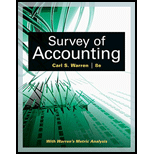
Concept explainers
Concept Introduction:
The fixed assets are of two types, one is tangible and other is intangible. The tangible assets are those which can be touched i.e. having a physical presence. An asset which is used in the business for more than one year and is subject to
Depreciation is the expense which is debited to income statement against the cost of asset i.e. cost of using the asset in the business or in other words, reduction in value due to wear, tear and obsolescence of the asset over its life.
The double-declining-balancing method is the method of computing the depreciation at the rate
The effects of using double-declining-balance depreciation instead of the straight-line method.
Trending nowThis is a popular solution!

Chapter 7 Solutions
Survey of Accounting (Accounting I)
- Please explain the correct approach for solving this general accounting question.arrow_forwardPlease explain the correct approach for solving this general accounting question.arrow_forwardPlease provide the correct answer to this financial accounting problem using accurate calculations.arrow_forward
- I am trying to find the accurate solution to this general accounting problem with the correct explanation.arrow_forwardI need assistance with this general accounting question using appropriate principles.arrow_forwardI need help with this general accounting problem using proper accounting guidelines.arrow_forward
- Can you solve this financial accounting problem with appropriate steps and explanations?arrow_forwardCan you solve this general accounting question with accurate accounting calculations?arrow_forwardCan you help me solve this general accounting question using the correct accounting procedures?arrow_forward
 Survey of Accounting (Accounting I)AccountingISBN:9781305961883Author:Carl WarrenPublisher:Cengage Learning
Survey of Accounting (Accounting I)AccountingISBN:9781305961883Author:Carl WarrenPublisher:Cengage Learning College Accounting, Chapters 1-27AccountingISBN:9781337794756Author:HEINTZ, James A.Publisher:Cengage Learning,Principles of Accounting Volume 1AccountingISBN:9781947172685Author:OpenStaxPublisher:OpenStax College
College Accounting, Chapters 1-27AccountingISBN:9781337794756Author:HEINTZ, James A.Publisher:Cengage Learning,Principles of Accounting Volume 1AccountingISBN:9781947172685Author:OpenStaxPublisher:OpenStax College Cornerstones of Financial AccountingAccountingISBN:9781337690881Author:Jay Rich, Jeff JonesPublisher:Cengage Learning
Cornerstones of Financial AccountingAccountingISBN:9781337690881Author:Jay Rich, Jeff JonesPublisher:Cengage Learning



